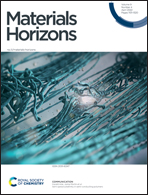Polymer dielectric films exhibiting superior high-temperature capacitive performance by utilizing an inorganic insulation interlayer†
Abstract
With the rapid development of next-generation electrical power equipment and microelectronics, there is an urgent demand for dielectric capacitor films which can work efficiently under extreme conditions. However, sharply increased electrical conduction and drastically degrading electric breakdown strength are inevitable at elevated temperatures. Herein, a facile but effective method is proposed to improve high temperature capacitive performance. We report that utilizing an inorganic insulation interlayer can significantly increase the discharge energy density with a high efficiency above 90% at 150 °C, i.e., a discharged energy density of 4.13 J cm−3 and an efficiency of >90% measured at 150 °C, which is superior to the state-of-the-art dielectric polymers. Combining the experimental results and computational simulations reveals that the remarkable improvement in energy storage performance at high temperature is attributed to the blocking effects that reduce the leakage current and maintain the breakdown strength. The proposed facile method provides great inspiration for developing polymer dielectric films with high capacitive performance under extreme environments.

- This article is part of the themed collections: Materials Horizons 10th anniversary regional spotlight collection: China, Materials Horizons 2022 Most Popular Articles and 2023 Materials Horizons Lunar New Year collection


 Please wait while we load your content...
Please wait while we load your content...